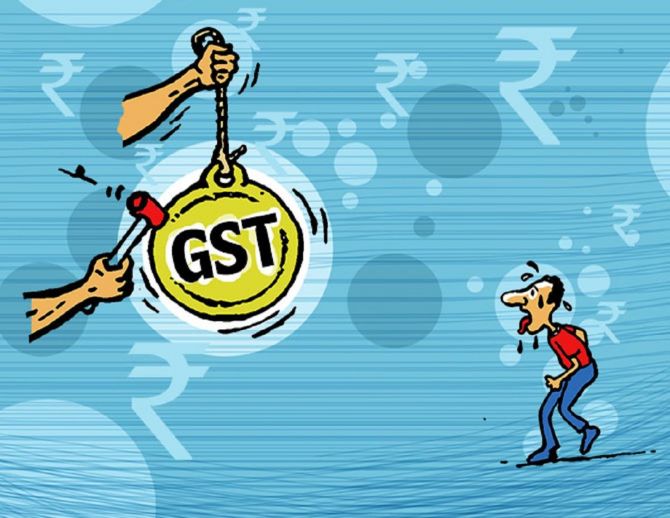The broad trends of GST collections will make you wonder if indeed the biggest indirect tax reform in the country has led to a real improvement in revenues, notes A K Bhattacharya.

The Modi government is elated over the steady improvement in the collection of goods and services tax (GST) in recent months. Along with the sharp growth in collections of other Union taxes, GST collections have also crossed the Rs 1 trillion mark for each of the last six months beginning July 2021.
Indeed, barring the months of May and June 2020, when the second wave of COVID-19 had adversely impacted the pace of economic activities, the monthly GST collections have stayed above the Rs 1 trillion mark for the last 15 months.
More recently, these collections have amounted to over Rs 1.3 trillion for each of the last three consecutive months of October to December, notching up growth rates of 13 to 26 per cent over the same months of 2020. Compared to the same months of 2019, the GST collections growth in October-December 2021 ranged between 26 and 37 per cent.
Apart from providing the much-needed revenue cushion to government finances, which are under stress because of a higher Covid-related expenditure commitment and a shortfall in disinvestment receipts during 2021-2022, the buoyancy in GST collections was a relief for those preparing the Budget. It is also seen as a sign of an economy that is bouncing back.
How justified is that perception? To answer this question, it will be important to understand the nature of the growth witnessed in GST collections in recent months. Identifying what factors could have contributed to this growth would help assess its sustainability in the coming months.
To begin with, let us look at the annual GST collections in the last three years. In 2018-2019, total GST collections were estimated at Rs 11.75 trillion, with a share of 6.22 per cent in gross domestic product, or GDP, and the average monthly collections at Rs 0.98 trillion. This was an improvement over the average monthly collection rate of Rs 0.9 trillion in 2017-2018 during the nine months since its launch in July 2017.
Covid did not make a big impact on the pace of economic activity in 2019-2020 as the lockdown was enforced only in the last week of March 2020. In a largely pre-pandemic year, total GST collections were estimated at only a slightly higher level of Rs 12.2 trillion with an average monthly rate of about Rs 1 trillion. But the GST collections' share in GDP in 2019-2020 dropped to about 6 per cent.
The performance in 2020-2021 was worse, thanks to the economic lockdown after the pandemic. Total GST collections fell to Rs 11.35 trillion at an average monthly rate of Rs 0.94 trillion, with their share in GDP further dropping to 5.75 per cent.
In the first nine months of 2021-2022, total GST collections are estimated at Rs 10.68 trillion, raising average monthly collection to about Rs 1.2 trillion. With India facing the third wave of Covid, it is unlikely that the GST collections in the remaining three months would exceed the average level witnessed in the previous nine months.
On that assumption, the full year's GST collections would be less than Rs 14.28 trillion or about 6.1 per cent of India's assumed GDP size.
Clearly, the share of GST collections in GDP is not a cause for any excitement. From 6.22 per cent of GDP in 2018-2019, it fell for two consecutive years to 6 per cent in 2019-2020 and 5.75 per cent in 2020-2021. And now in 2021-2022, it is expected to go up to 6.1 per cent of GDP.
The ratio of GST to GDP is the true indicator of measuring how tax revenues have kept pace with the economy's growth.
By that yardstick, there is no reason for any elation, even though in nominal terms the collections in 2021-2022 could grow by about 25 per cent over the previous year with an improved buoyancy.
There is another way of looking at how the GST collections have fared in the last few years. GST collections take place under four broad categories: Central GST (CGST), State GST (SGST), Integrated GST (IGST) and Compensation Cess.
The trajectory of growth in collections under these heads highlights the need for specific administrative as well as policy interventions in each of these areas.
In 2018-2019, for instance, the collection under CGST used to be about Rs 17,000 crore every month on average. In the first nine months of 2021-2022, this has gone up by 29 per cent to a monthly average of Rs 22,000 crore.
However, SGST has recorded lower growth in this period of about 22 per cent from an average monthly collection of Rs 23,000 crore to Rs 28,000 crore. The state governments are responsible for collection of SGST, while the CGST is collected by the Centre.
The slower growth in SGST could reflect the inefficient tax collection machinery that many states may be burdened with. This may require some attention from the tax administration point of view.
Far worse is the performance of IGST collection for inter-state supplies. Between 2018-2019 and 2021-2022, the monthly average figure moved up by just 19 per cent from Rs 26,000 crore in 2018-2019 to Rs 31,000 crore.
The problem here does not seem to be related to the collection system. IGST is collected by the Centre. Why then have IGST collections on inter-state-supplies seen a lower growth rate?
But in contrast, IGST for imports has increased by 25 per cent in this period from Rs 24,000 crore a month to Rs 30,000 crore a month. This raises a larger question of how IGST for imports has become the largest component in the total GST basket, at least in the last three months from October to December 2021.
Indeed, even as CGST, SGST and IGST for inter-state supplies either declined or plateaued in the October-December 2021 period, IGST for imports showed a steady rise. Perhaps a rise in India's imports, along with higher tariffs, has contributed to this growth in GST collections, particularly in the third quarter of 2021-2022.
The systemic ease with which taxes could be collected on imports at the port of entry into the country could also be responsible for the higher growth.
That leaves the compensation cess, whose average monthly collection has ranged between Rs 8,000 crore and Rs 9,000 crore in the last three years. The cess was levied for a fixed period of five years from July 2017 to compensate the states for their revenue loss after the GST rollout.
The states have now asked for the continuation of the cess for another five years after June 2022. Given the states' fiscal stress, the demand for continuing the cess cannot be easily ignored by the Centre, even though the stagnation in its collection pace is a puzzle.
But the broad trends of the GST collections will make you wonder if indeed the biggest indirect tax reform in the country has led to a real improvement in revenues.
With the GST collections' share in GDP in 2021-2022 yet to go past the figure reached three years ago, questions are bound to be raised on the efficacy of recent tax administration reforms like tracking fake bills to prevent evasion.
More importantly, the GST Council can no longer postpone the much-needed reforms in the tax rates by unifying them under two or three slabs. This might mean GST rates for several items would go up.
The Modi government so far has shown reluctance to raise tax rates, except in Customs.
The time to consider a GST rate rationalisation to achieve an overall increase in effective rates has come.











